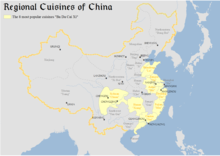
Back Gastronomía de Cantón Spanish Kantoni köök Estonian Cuisine cantonaise French Hidangan Kanton ID Cucina cantonese Italian 広東料理 Japanese Olahan Kanton JV კანტონური სამზარეულო Georgian 광둥 요리 Korean Kantono virtuvė Lithuanian
This article needs additional citations for verification. (September 2024) |
| Cantonese cuisine | |||||||||||||||||||||||
|---|---|---|---|---|---|---|---|---|---|---|---|---|---|---|---|---|---|---|---|---|---|---|---|
 Chefs cook with a wok | |||||||||||||||||||||||
| Traditional Chinese | 廣東菜 | ||||||||||||||||||||||
| Simplified Chinese | 广东菜 | ||||||||||||||||||||||
| Jyutping | Gwong2 dung1 coi3 | ||||||||||||||||||||||
| Cantonese Yale | Gwóng dūng choi | ||||||||||||||||||||||
| |||||||||||||||||||||||
| Yue cuisine | |||||||||||||||||||||||
| Traditional Chinese | 粵菜 | ||||||||||||||||||||||
| Simplified Chinese | 粤菜 | ||||||||||||||||||||||
| Jyutping | Jyut6 coi3 | ||||||||||||||||||||||
| Cantonese Yale | Yuht choi | ||||||||||||||||||||||
| |||||||||||||||||||||||

Cantonese or Guangdong cuisine, also known as Yue cuisine (Chinese: 廣東菜 or 粵菜), is the cuisine of Guangdong province of China, particularly the provincial capital Guangzhou, and the surrounding regions in the Pearl River Delta including Hong Kong and Macau.[1] Strictly speaking, Cantonese cuisine is the cuisine of Guangzhou or of Cantonese speakers, but it often includes the cooking styles of all the speakers of Yue Chinese languages in Guangdong.
The Teochew cuisine and Hakka cuisine of Guangdong are considered their own styles. However, scholars may categorize Guangdong cuisine into three major groups based on the region's dialect: Cantonese, Hakka and Chaozhou cuisines.[2] Neighboring Guangxi's cuisine is also considered separate despite eastern Guangxi being considered culturally Cantonese due to the presence of ethnic Zhuang influences in the rest of the province.
Cantonese cuisine is one of the Eight Great Traditions of Chinese cuisine. Its prominence outside China is due to the large number of Cantonese emigrants. Chefs trained in Cantonese cuisine are highly sought after throughout China.[3] Until the late 20th century, most Chinese restaurants in the West served largely Cantonese dishes.
- ^ Hsiung, Deh-Ta. Simonds, Nina. Lowe, Jason. [2005] (2005). The food of China: a journey for food lovers. Bay Books. ISBN 978-0-681-02584-4. p17.
- ^ Klein, Jakob A. (October 2007). "Redefining Cantonese cuisine in post-Mao Guangzhou". Bulletin of the School of Oriental and African Studies. 70 (3): 511–537. doi:10.1017/S0041977X07000821. ISSN 0041-977X. S2CID 146794802.
- ^ Civitello, Linda (23 March 2011). Cuisine and Culture: A History of Food and People. Wiley. p. 281. ISBN 9781118098752.